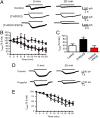Neurosteroids promote phosphorylation and membrane insertion of extrasynaptic GABAA receptors
- PMID: 24778259
- PMCID: PMC4024867
- DOI: 10.1073/pnas.1403285111
Neurosteroids promote phosphorylation and membrane insertion of extrasynaptic GABAA receptors
Abstract
Neurosteroids are synthesized within the brain and act as endogenous anxiolytic, anticonvulsant, hypnotic, and sedative agents, actions that are principally mediated via their ability to potentiate phasic and tonic inhibitory neurotransmission mediated by γ-aminobutyric acid type A receptors (GABAARs). Although neurosteroids are accepted allosteric modulators of GABAARs, here we reveal they exert sustained effects on GABAergic inhibition by selectively enhancing the trafficking of GABAARs that mediate tonic inhibition. We demonstrate that neurosteroids potentiate the protein kinase C-dependent phosphorylation of S443 within α4 subunits, a component of GABAAR subtypes that mediate tonic inhibition in many brain regions. This process enhances insertion of α4 subunit-containing GABAAR subtypes into the membrane, resulting in a selective and sustained elevation in the efficacy of tonic inhibition. Therefore, the ability of neurosteroids to modulate the phosphorylation and membrane insertion of α4 subunit-containing GABAARs may underlie the profound effects these endogenous signaling molecules have on neuronal excitability and behavior.
Keywords: PKC; current rundown; receptor insertion; tonic current.
Conflict of interest statement
The authors declare no conflict of interest.
Figures







Similar articles
-
Phosphorylation of GABAA receptors influences receptor trafficking and neurosteroid actions.Psychopharmacology (Berl). 2014 Sep;231(17):3453-65. doi: 10.1007/s00213-014-3617-z. Epub 2014 May 22. Psychopharmacology (Berl). 2014. PMID: 24847959 Free PMC article. Review.
-
Metabotropic, but not allosteric, effects of neurosteroids on GABAergic inhibition depend on the phosphorylation of GABAA receptors.J Biol Chem. 2019 Aug 9;294(32):12220-12230. doi: 10.1074/jbc.RA119.008875. Epub 2019 Jun 25. J Biol Chem. 2019. PMID: 31239352 Free PMC article.
-
Protein kinase C phosphorylation regulates membrane insertion of GABAA receptor subtypes that mediate tonic inhibition.J Biol Chem. 2010 Dec 31;285(53):41795-805. doi: 10.1074/jbc.M110.149229. Epub 2010 Oct 12. J Biol Chem. 2010. PMID: 20940303 Free PMC article.
-
GABAAR isoform and subunit structural motifs determine synaptic and extrasynaptic receptor localisation.Neuropharmacology. 2020 Jun 1;169:107540. doi: 10.1016/j.neuropharm.2019.02.022. Epub 2019 Feb 19. Neuropharmacology. 2020. PMID: 30794836
-
GABA-A Receptors Mediate Tonic Inhibition and Neurosteroid Sensitivity in the Brain.Vitam Horm. 2018;107:177-191. doi: 10.1016/bs.vh.2017.12.001. Epub 2018 Feb 9. Vitam Horm. 2018. PMID: 29544630 Review.
Cited by
-
Daily isoflurane exposure increases barbiturate insensitivity in medullary respiratory and cortical neurons via expression of ε-subunit containing GABA ARs.PLoS One. 2015 Mar 6;10(3):e0119351. doi: 10.1371/journal.pone.0119351. eCollection 2015. PLoS One. 2015. PMID: 25748028 Free PMC article.
-
Distinct mechanisms of allopregnanolone and diazepam underlie neuronal oscillations and differential antidepressant effect.Front Cell Neurosci. 2024 Jan 8;17:1274459. doi: 10.3389/fncel.2023.1274459. eCollection 2023. Front Cell Neurosci. 2024. PMID: 38259500 Free PMC article.
-
Pathophysiology of convulsive status epilepticus.Seizure. 2019 May;68:16-21. doi: 10.1016/j.seizure.2018.08.002. Epub 2018 Aug 6. Seizure. 2019. PMID: 30170734 Free PMC article. Review.
-
Inhibitory and excitatory synaptic neuroadaptations in the diazepam tolerant brain.Neurobiol Dis. 2023 Sep;185:106248. doi: 10.1016/j.nbd.2023.106248. Epub 2023 Aug 1. Neurobiol Dis. 2023. PMID: 37536384 Free PMC article.
-
Allopregnanolone: An overview on its synthesis and effects.J Neuroendocrinol. 2022 Feb;34(2):e12996. doi: 10.1111/jne.12996. Epub 2021 Jun 29. J Neuroendocrinol. 2022. PMID: 34189791 Free PMC article. Review.
References
-
- Belelli D, Lambert JJ. Neurosteroids: Endogenous regulators of the GABA(A) receptor. Nat Rev Neurosci. 2005;6(7):565–575. - PubMed
-
- Paul SM, Purdy RH. Neuroactive steroids. FASEB J. 1992;6(6):2311–2322. - PubMed
-
- Crawley JN, Glowa JR, Majewska MD, Paul SM. Anxiolytic activity of an endogenous adrenal steroid. Brain Res. 1986;398(2):382–385. - PubMed
Publication types
MeSH terms
Substances
Grants and funding
- NS056359/NS/NINDS NIH HHS/United States
- R01 MH097446/MH/NIMH NIH HHS/United States
- NS051195/NS/NINDS NIH HHS/United States
- R01 NS051195/NS/NINDS NIH HHS/United States
- P01 NS054900/NS/NINDS NIH HHS/United States
- MH097446/MH/NIMH NIH HHS/United States
- R01 NS056359/NS/NINDS NIH HHS/United States
- R01 NS047478/NS/NINDS NIH HHS/United States
- R01 NS073574/NS/NINDS NIH HHS/United States
- R01 NS048045/NS/NINDS NIH HHS/United States
- R01 MH118263/MH/NIMH NIH HHS/United States
- R01 NS102937/NS/NINDS NIH HHS/United States
- R01 NS081986/NS/NINDS NIH HHS/United States
- NS081735/NS/NINDS NIH HHS/United States
- T32 NS061764/NS/NINDS NIH HHS/United States
LinkOut - more resources
Full Text Sources
Other Literature Sources
Molecular Biology Databases

